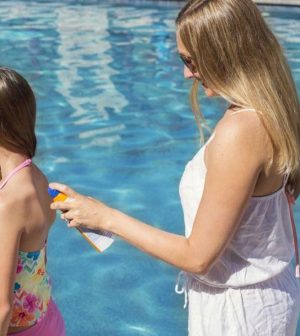- Navigating Your Midlife Crisis: Embracing New Possibilities
- City Raccoons Showing Signs of Domestication
- Mapping the Exposome: Science Broadens Focus to Environmental Disease Triggers
- One Week Less on Social Media Linked to Better Mental Health
- Your Brain Changes in Stages as You Age, Study Finds
- Some Suicide Victims Show No Typical Warning Signs, Study Finds
- ByHeart Formula Faces Lawsuits After Babies Sickened With Botulism
- Switch to Vegan Diet Could Cut Your Greenhouse Gas Emissions in Half
- Regular Bedtime Does Wonders for Blood Pressure
- Dining Alone Could Mean Worse Nutrition for Seniors
Many Americans Confused About Sunscreens: Poll

Think you know all you need to know about slathering on the sunscreen this summer?
Maybe you don’t.
As the Memorial Day weekend begins, many Americans are confused about the proper application of sunscreen and about its sun protection factor (SPF), the American Academy of Dermatology (AAD) says.
A recent academy poll of 1,000 U.S. adults found that while 80% know they should apply sunscreen every two hours when outdoors, only 33% typically do so, while 42% typically don’t reapply it at all or reapply it only when they get wet.
Three in 10 respondents said they apply sunscreen only to their face, leaving other areas of their body unprotected.
A recent report in the journal JAMA Dermatology found that most Americans consider the SPF rating to be the most important criteria when selecting sunscreen.
“There is a lot of information on sunscreen labels, and one piece of information isn’t necessarily more important than another,” said Dr. Henry Lim, former chair of the department of dermatology at Henry Ford Hospital in Detroit.
“I tell my patients to look for three things when choosing a sunscreen — SPF 30 or higher, broad-spectrum protection, and water resistance,” Lim said in an AAD news release.
An SPF 30 sunscreen blocks 97% of the sun’s UVB rays, and higher-number SPFs block slightly more of those rays, but no sunscreen can block 100% of the sun’s UVB rays.
“Reapplication is key, along with understanding SPF,” Lim said. “Many people mistakenly assume that they can apply the sunscreen with the highest SPF rating and then stay out in the sun all day without reapplying; however, SPF is a measurement of how well a sunscreen protects the skin from the sun’s UVB rays, which cause sunburn. It is not a measurement of how long someone can stay in the sun or how frequently it needs to be applied.”
There are three simple steps to sun protection, according to the AAD.
- Seek shade, and keep in mind that the sun’s rays are strongest between 10 a.m. and 2 p.m.
- Wear sun-protective clothing, such as a lightweight, long-sleeved shirt, pants, a wide-brimmed hat and sunglasses with UV protection, when possible. For more effective sun protection, wear clothing with an ultraviolet protection factor (UPF) number on the label.
- Apply a broad-spectrum, water-resistant sunscreen with an SPF of 30 or higher to all skin not covered by clothing. Reapply every two hours when outdoors or after swimming or sweating.
More information
The U.S. Centers for Disease Control and Prevention has more on sun safety.
SOURCE: American Academy of Dermatology, news release, May 25, 2021
Source: HealthDay
Copyright © 2025 HealthDay. All rights reserved.










